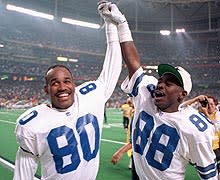Infamous Cowboys White House still stands

IRVING, Texas – The notorious house stands regal at the end of a cul-de-sac named for the Dallas Cowboys' great running back Tony Dorsett; a brown brick fortress with giant picture windows and a two-car garage at the bottom. Behind the house runs a canal. And behind the canal is the Cowboys' Valley Ranch headquarters, so close you can surely hear the coaches' practice whistles on a breezy day.
A recent real estate listing says the house was valued at $294,500 – this probably because of the extensive renovation a few years back in which everything was painted, new carpeting tacked down and granite countertops installed in the kitchen. The listing makes no mention of the handful of Cowboys players who made it a second home in the mid-1990s, calling it the White House and using the five bedrooms and 3.1 bathrooms for acts far less pure than the "play football" amenity the listing suggests.
It's hard to know if the current residents of the White House know its inglorious history. No one answered the door on a recent Sunday. And despite a pleasant afternoon sun, no one seemed to be outside on Dorsett Drive, nor on the nearby Meredith Drive. Landry Court was also quiet. Only an occasional car rolled down the Cowboys Parkway. It was as if the whole happy Cowboys neighborhood had been abandoned.
Yet for a time about 15 years ago, the peace was tested.
Consider this passage printed in The Guardian from Jeff Pearlman, the author of "Boys Will Be Boys," the story of the decadent 1990s Cowboys.
"The house … was rented under the name of receiver Alvin Harper and the new neighbors in an exclusively white, low-key community were 6-foot-5 inch, 300 pound African American men escorting an endless conveyor belt of large-breasted blondes. Nate Newton insists the White House was a haven for neither prostitution ("What did we need a prostitute for? Women laid down for us") nor drugs (Never saw 'em), yet his take is disputed by myriad teammates and people in the know."
When the house and its tenants' purpose became public just after the apex of the Cowboys' Super Bowl runs, this screamed of a team out of control. A television station's hidden camera caught star receiver Michael Irvin with what appeared to be cocaine. Wrapped around were a string of other arrests and other publicly embarrassing situations that made it football's most interesting franchise back then.
The days of the White House are long gone. Today's Cowboys are tamer, the league is quieter. A conduct policy now exists, managed arbitrarily by commissioner Roger Goodell. Whether it has had an effect on how players behave in public, there is little doubt they are more careful now.
The teams in this Super Bowl are nothing like the Cowboys of the White House. The most controversial player here, Ben Roethlisberger(notes), has vowed to change his life and the most sensational thing he has apparently done since arriving in town is take his offensive line out for drinks, paying for everything, tipping well and briefly singing with a piano man.
Standing outside the White House it's almost impossible to imagine what it must have been like when the Cowboys roamed the halls. A story at the time in the Los Angeles Times quoted a neighbor as saying he saw all kinds of women walking in and out of the house. He asked another neighbor what she thought was going on and she told him she had seen "women through the window, running around in their birthday suits."
Pearlman, in his book, adds more detail writing that the house was wired with video cameras, installed by a friend of Irvin's. According to Pearlman, the receiver never told the other players they were being taped.
Not that anyone probably minded, the Cowboys of those days seemed above almost any law.
Then they fell. It's hard to know how much of the collapse was excess. A stronger salary cap forced teams like Dallas and San Francisco to shed key players who weren't deemed as critical to keep as the superstars. Some of the team's more outlandish stars, like Charles Haley, left. Irvin found religion.
Within two years the Cowboys were no longer the Cowboys. The lease had long expired on the White House. The neighborhood was quiet again. And the brief, flamboyant run of the 1990s Cowboys faded into the past.
